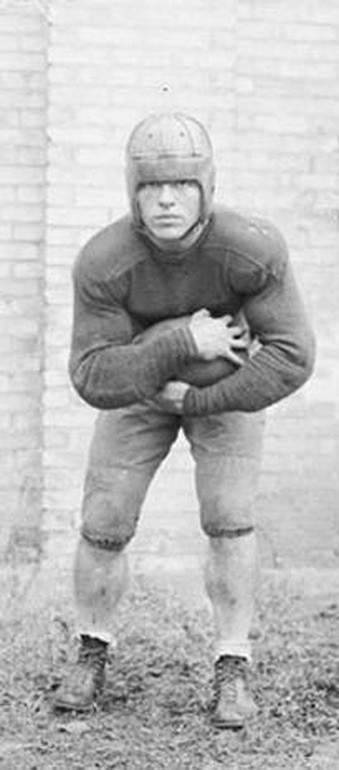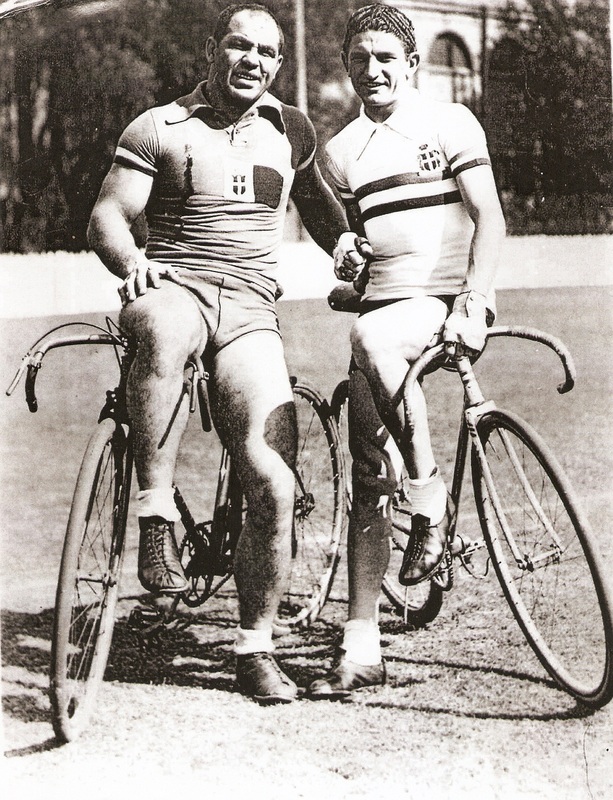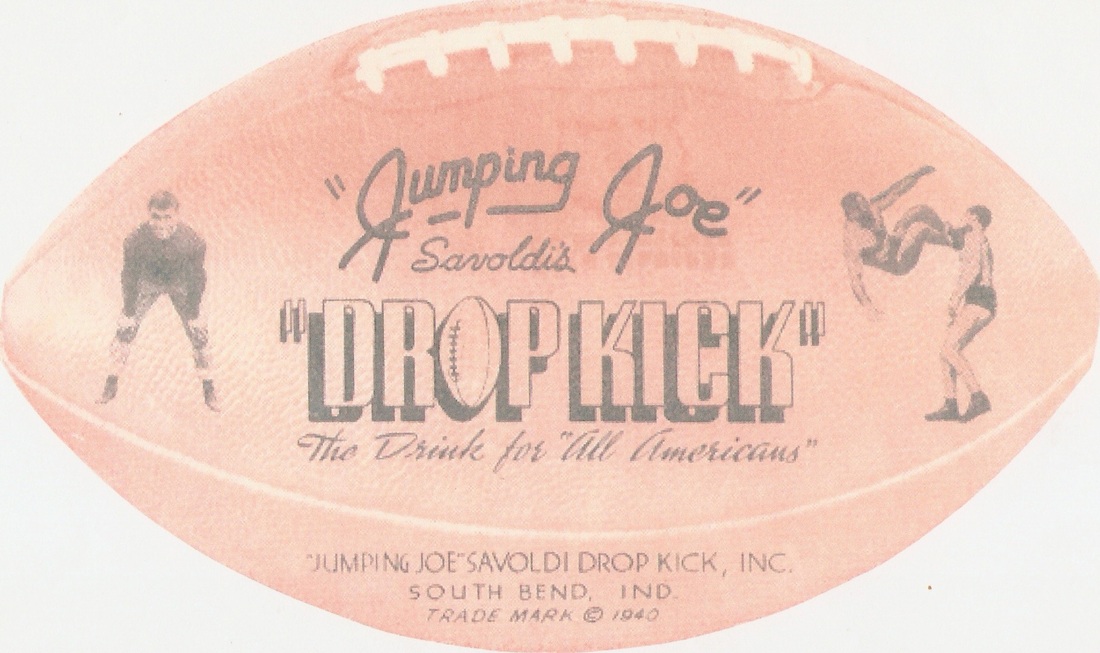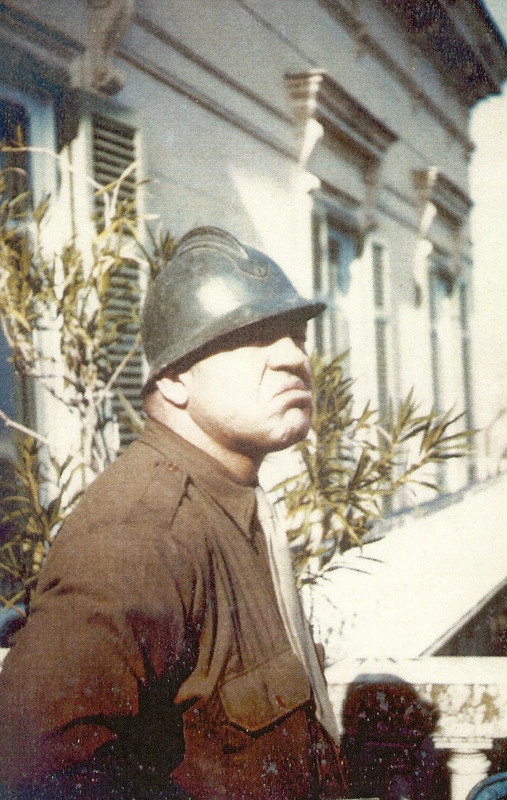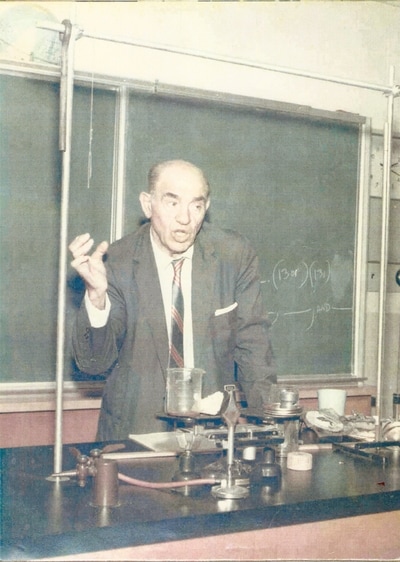
Italian version
Joseph Anthony Savoldi (JUMPING JOE)
With the contribution of Jim Savoldi nephew Jumping Joe Savoldi Savoldi
Translation Luca De Bernardi
Adaptation and search: Angelo Fornara, Aspesi Alberto e Luca De Bernardi
With the contribution of Jim Savoldi nephew Jumping Joe Savoldi Savoldi
Translation Luca De Bernardi
Adaptation and search: Angelo Fornara, Aspesi Alberto e Luca De Bernardi
 Corso S. Rocco: evidenced in yellow Rudoni’s activity
Corso S. Rocco: evidenced in yellow Rudoni’s activity
Joseph Anthony Savoldi was born and grew up in Castano Primo. He distinguished himself as an athlete, in the Armed Forces, and in his work. Obviously, though, it all began with his ancestors - Giuseppe Rudoni (1843-1908) and Maria Speroni (1852-1927), both born and brought up in Castano Primo, in Corso San Rocco, where Giuseppe ran an osteria - a sort of ‘pub’ - and dealt in wines. Today the premises are occupied by a household goods shop called “Tutto Per la Casa”. They had six children, Stefano, Teresa, Bianca, Celeste, Giovanni and Ambrogio.
As often happened in the early 1900s, many people from Castano, seeking success, took the tough decision to emigrate, most of them to the United States or Argentina. Thus, in 1905, at the age of 18, Celeste Rudoni, the future mother of Joseph Anthony Savoldi, disembarked in the USA and on 2 August of that year she married Giuseppe Savoldi, born in 1884, who originally came from Trescore Balneario in the Province of Bergamo, but had been in America since 1891. As was the custom in those times, the marriage had been arranged by the two families, in the hope of creating a happy union for their children in this land far from home. In 1905 Celeste, who was living with her husband in the township of Three Oaks in the state of Michigan, saw her dream – shared by many immigrants – come true: she was granted American citizenship!
1908 was a memorable year for Celeste, who was then pregnant and fully integrated in American life but then she received bad news from Castano Primo, and had to tackle the long trip back to Italy. Maria Speroni, her mother, had asked her daughter to come back as her father was on his deathbed: he had been badly beaten up in February that year by a bunch of unscrupulous bandits, while he was crossing the River Ticino near Galliate, with a boatload of wine.
Not long after she reached Castano, on 5 March 1908 at 3 in the morning, Giuseppe Savoldi was born – later to be known as Joseph Anthony. That very day at 9 in the evening, her father Giuseppe Rudoni died from complications due to the wounds inflicted by the thieves.
As often happened in the early 1900s, many people from Castano, seeking success, took the tough decision to emigrate, most of them to the United States or Argentina. Thus, in 1905, at the age of 18, Celeste Rudoni, the future mother of Joseph Anthony Savoldi, disembarked in the USA and on 2 August of that year she married Giuseppe Savoldi, born in 1884, who originally came from Trescore Balneario in the Province of Bergamo, but had been in America since 1891. As was the custom in those times, the marriage had been arranged by the two families, in the hope of creating a happy union for their children in this land far from home. In 1905 Celeste, who was living with her husband in the township of Three Oaks in the state of Michigan, saw her dream – shared by many immigrants – come true: she was granted American citizenship!
1908 was a memorable year for Celeste, who was then pregnant and fully integrated in American life but then she received bad news from Castano Primo, and had to tackle the long trip back to Italy. Maria Speroni, her mother, had asked her daughter to come back as her father was on his deathbed: he had been badly beaten up in February that year by a bunch of unscrupulous bandits, while he was crossing the River Ticino near Galliate, with a boatload of wine.
Not long after she reached Castano, on 5 March 1908 at 3 in the morning, Giuseppe Savoldi was born – later to be known as Joseph Anthony. That very day at 9 in the evening, her father Giuseppe Rudoni died from complications due to the wounds inflicted by the thieves.
 Castano Primo 1914: J.Anthony Savoldi with his grandmother and parents
Castano Primo 1914: J.Anthony Savoldi with his grandmother and parents
Only a few days later Celeste was due to travel back home to her husband, who was anxious to see his first-born! But the little boy was not ready to face the long ocean crossing safely, so Celeste decided to depart all the same, leaving little Joseph with grandmother Maria, hoping to come back soon to take him back.
A few months later, however, when Celeste did manage to return to Castano, she was still unlucky – her son had whooping cough, an infectious disease, so he could not travel, and mother and child were again destined to part.
When the Great War started and navigation became very risky, the young Joseph A. Savoldi ended up spending his childhood years in Castano Primo, and only managed to rejoin his family in Three Oaks in 1918.
A few months later, however, when Celeste did manage to return to Castano, she was still unlucky – her son had whooping cough, an infectious disease, so he could not travel, and mother and child were again destined to part.
When the Great War started and navigation became very risky, the young Joseph A. Savoldi ended up spending his childhood years in Castano Primo, and only managed to rejoin his family in Three Oaks in 1918.
In America he attended the Three Oaks High School, where he earned his diploma, and moved on to the prestigious Notre Dame University. There, starting in 1928, he became a university football star, playing for the Fighting Irish team coached by Knute Rockne. It was in those years that he acquired two nicknames - “Galloping Joe” and the one that was to follow him throughout his life, “Jumping Joe” which he had earned after a magnificent touchdown during the 1929 season, against the Carnegie Tech team, when in one vast leap he cleared the whole of the opposing team’s defence line!
|
Savoldi’s football career led him in 1930 to sign a contract as a professional with the famous Chicago Bears, and that team won numerous games in the American national championships - the NFL (National Football League). The game that changed his life, however, was when his old team, the Fighting Irish, invited him to join up with them against a team made up of some of the best players in South-West America. The match, played out in the Los Angeles Coliseum, ended with a brilliant victory for the “Irish” who won 20 to 7. Savoldi’s part in the match left everyone agape, and two of the spectators – both great football fans – were also talent scouts for wrestling The two of them, Billy Sandow and Ed “Strangler” Lewis (Lewis at the time was world wrestling champion) contacted Savoldi, offering him a contract for the coming season with a fee for one wrestling match much fatter than what he earned in a whole year with the Chicago Bears. Savoldi accepted. |
source magazine Atlantica :
“Italic Institute of America – Guardian of the Italian Heritage“
www.italic.org
“Italic Institute of America – Guardian of the Italian Heritage“
www.italic.org
From that moment his life changed and he became a star of the wrestling world. Savoldi’s best-known ‘technical move’ was his ‘dropkick’ which he used to end almost every match.
On 7 April 1933, at the Chicago Stadium, Savoldi fought a decisive match against the heavyweight world champion, Jim London; the referee, Bod Managoff, declared Savoldi the winner, so Savoldi became the champion.
This victory was severely criticized by London, who went on calling himself World Champion, complaining that there had been irregularities due to tangled ropes.
On 7 April 1933, at the Chicago Stadium, Savoldi fought a decisive match against the heavyweight world champion, Jim London; the referee, Bod Managoff, declared Savoldi the winner, so Savoldi became the champion.
This victory was severely criticized by London, who went on calling himself World Champion, complaining that there had been irregularities due to tangled ropes.
 1933 J.A. Savoldi wins against Jim London
1933 J.A. Savoldi wins against Jim London
Not much later, however, Savoldi suffered two important defeats. The first was on 12 June 1933 at the Yankee Stadium in New York, where he lost to Jim Browning and the second, on 31 January 1934 at the Chicago Stadium, was against his long-time rival Jim London. This must have been one of the most widely followed fights in the history of wrestling until then, as more than 20,000 spectators crowded the stadium.
Despite these discouraging defeats, Savoldi carried on fighting as a professional wrestler for another ten years or so, taking part in numerous tours in New Zealand, Hawaii and Australia in 1936 and 1937.
Despite these discouraging defeats, Savoldi carried on fighting as a professional wrestler for another ten years or so, taking part in numerous tours in New Zealand, Hawaii and Australia in 1936 and 1937.
Some of matches di J.A. Savoldi
|
|
|
|
|
|
In 1941 Savoldi, who was becoming increasingly popular, founded in Buchannen, in the State of Michigan, a distribution company for a beer known as Red Top Beer and thought up a special drink – precursor of today’s ‘energy drinks’ - that he baptized ‘Dropkick’. The business soon found itself in difficulty, and when the USA entered the second world war and sugar rationing started, production of the new drink became impossible and the project was abandoned.
|
above: 1940 The Mark of the energizing drink invented by JA Savoldi
under: Certification of registration of the trademark energy drink "DROP KICK" at the US Chamber of Commerce http://trademarks.justia.com/853/26/jumping-joe-savoldi-s-drop-kick-the-drink-for-all-americans-85326451.html |
|
Early in the second world war, Joseph Anthony Savoldi, like many of his compatriots, was called up to serve the nation. With his origins, physical appearance and perfectly fluent Italian, he was considered the ideal candidate to join the OSS (today’s CIA, the American secret service).
He was trained as a secret agent with the idea that if necessary he would be sent to Italy with a false identify, as he could easily pass for a native and take part in espionage operations. And that is what happened. Savoldi spent the war in Italy as an under-cover agent, collaborating with the Italian resistance and taking part in a series of courageous actions behind the enemy lines. |
Request Commander E.Breed for promotion to officer JASavoldi 03/08/1944
original text
original text
When he was demobbed at the end of the war, Savoldi took up wrestling again, but his movements in the ring were drastically hindered because he suffered from severe arthritis. Between 1946 and 1948 Savoldi continued wrestling, however, and introduced an emerging star to the sport, Bobo Brazil.
J.A. Savoldi’s last fight was in 1950, after which he retired from the sporting scene. He never lost his desire to be ‘in the game’, however, and seriously worked toward another personal goal, studying hard to earn his diploma as a science teacher.
He then joined the teaching staff of the County High School in Henderson, Kentucky.
Joseph Anthony Savoldi died in 1974, leaving a bereaved family and many memories of exciting moments and adventures.
He is buried in the Henderson cemetery.
J.A. Savoldi’s last fight was in 1950, after which he retired from the sporting scene. He never lost his desire to be ‘in the game’, however, and seriously worked toward another personal goal, studying hard to earn his diploma as a science teacher.
He then joined the teaching staff of the County High School in Henderson, Kentucky.
Joseph Anthony Savoldi died in 1974, leaving a bereaved family and many memories of exciting moments and adventures.
He is buried in the Henderson cemetery.
Commemorative plaque placed in the Henderson County High School in Kentucky
J.A.Savoldi where he taught until 1973
A big thank you goes to Mrs Tracy Bailey, HCH School Secretary for the friendliness and the material supplied
J.A.Savoldi where he taught until 1973
A big thank you goes to Mrs Tracy Bailey, HCH School Secretary for the friendliness and the material supplied
The text on the plaque
JUMPIN’ JOE SAVOLDI 1908-1974
FULLBACK-NOTRE DAME 1929-30
ALL AMERICAN-UNDEFEATED
HALFBACK-CHICAGO BEARS 1931
WORLD’S HEAVYWEIGHT WRESTLING CHAMPION 1933-35
OFFICE OF STRATEGIC SERVICES-WORLD WAR II
TEACHER, HENDERSON COUNTY HIGH SCHOOL 1962-73
“WE PLAY THE GAME TO WIN- WITH HONOR”
KNUTE ROCKNE
FULLBACK-NOTRE DAME 1929-30
ALL AMERICAN-UNDEFEATED
HALFBACK-CHICAGO BEARS 1931
WORLD’S HEAVYWEIGHT WRESTLING CHAMPION 1933-35
OFFICE OF STRATEGIC SERVICES-WORLD WAR II
TEACHER, HENDERSON COUNTY HIGH SCHOOL 1962-73
“WE PLAY THE GAME TO WIN- WITH HONOR”
KNUTE ROCKNE
Surces:
1. Young, Rick (September 2003). "Out of Bounds". Irish Reveries (IrishLegends.com) 6 (1).
2. Munsey, Paul and Cory Suppes. "Notre Dame Stadium". NCAA Past, Present & Future Stadiums. BALLPARKS.com.
3. Couch, Jason (November 2007). "Was Savate’s Drop Kick from Pro Wrestling?". MartialHistory.com.
4. "Savoldi Family Says, "Country Needs a Good DROPKICK"". Dropkick.com. 2003. Archived from the original
on September 27, 2007.
5. The OSS Society (Summer 2005). "Information Sought on OSSer "Jumping Joe" Savoldi". OSSsociety.org.
6. Friend, Percival A. (December 2, 2002). "The Way It Was -- The Birth of BubuBrasil".
The Way It Was by Percival A. Friend. Archived from the original on October 28, 2009.
7. "World / International Heavyweight Title (Montreal)". Wrestling-Titles.com. PuroresuDojo. 2003. Retrieved 9 June 2010.
8. "European Heavyweight Title". Wrestling-Titles.com. Puroresu Dojo. 2003. Retrieved 9 June 2010.
9. "Rocky Mountain Heavyweight Title". Wrestling-Titles.com. Puroresu Dojo. 2003. Retrieved 9 June 2010.
10. http://www.irishlegends.com
11. “Italic Institute of America – Guardian of the Italian Heritage" www.italic.org
1. Young, Rick (September 2003). "Out of Bounds". Irish Reveries (IrishLegends.com) 6 (1).
2. Munsey, Paul and Cory Suppes. "Notre Dame Stadium". NCAA Past, Present & Future Stadiums. BALLPARKS.com.
3. Couch, Jason (November 2007). "Was Savate’s Drop Kick from Pro Wrestling?". MartialHistory.com.
4. "Savoldi Family Says, "Country Needs a Good DROPKICK"". Dropkick.com. 2003. Archived from the original
on September 27, 2007.
5. The OSS Society (Summer 2005). "Information Sought on OSSer "Jumping Joe" Savoldi". OSSsociety.org.
6. Friend, Percival A. (December 2, 2002). "The Way It Was -- The Birth of BubuBrasil".
The Way It Was by Percival A. Friend. Archived from the original on October 28, 2009.
7. "World / International Heavyweight Title (Montreal)". Wrestling-Titles.com. PuroresuDojo. 2003. Retrieved 9 June 2010.
8. "European Heavyweight Title". Wrestling-Titles.com. Puroresu Dojo. 2003. Retrieved 9 June 2010.
9. "Rocky Mountain Heavyweight Title". Wrestling-Titles.com. Puroresu Dojo. 2003. Retrieved 9 June 2010.
10. http://www.irishlegends.com
11. “Italic Institute of America – Guardian of the Italian Heritage" www.italic.org




